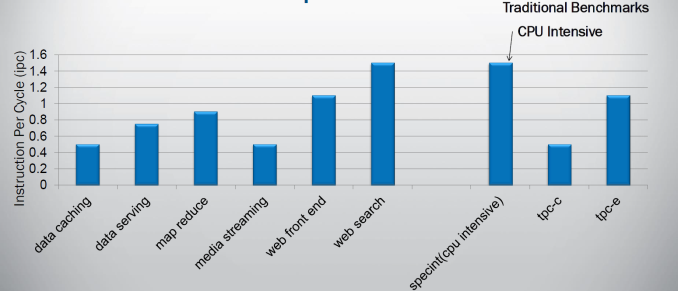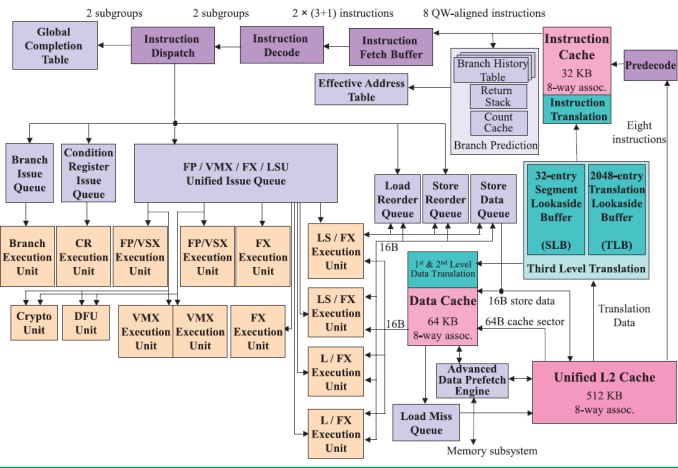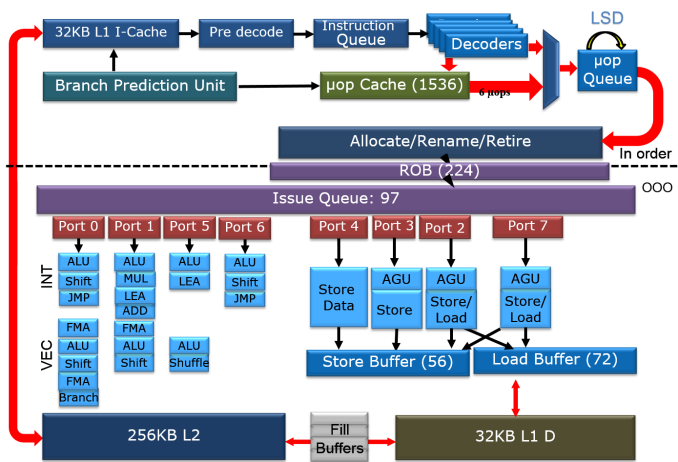Assessing IBM's POWER8, Part 1: A Low Level Look at Little Endian
by Johan De Gelas on July 21, 2016 8:45 AM ESTInside the Beast(s)
When the POWER8 was first launched, the specs were mind boggling. The processor could decode up to 8 instructions, issue 8 instructions, and execute up to 10 and all this at clockspeed up to 4.5 GHz. The POWER8 is thus an 8-way superscalar out of order processor. Now consider that
- The complexity of an architecture generally scales quadratically with the number of "ways" (hardware parallelism)
- Intel's most advanced architecture today - Skylake - is 5-way
and you know this is a bold move. If you superficially look at what kind of parallelism can be found in software, it starts to look like a suicidal move. Indeed on average, most modern CPU compute on average 2 instructions per clockcycle when running spam filtering (perlbench), video encoding (h264.ref) and protein sequence analyses (hmmer). Those are the SPEC CPU2006 integer benchmarks with the highest Instruction Per Clockcycle (IPC) rate. Server workloads are much worse: IPC of 0.8 and less are not an exception.
It is clear that simply widening a design will not bring good results, so IBM chose to run up to 8 threads simultaneously on their core. But running lots of threads is not without risk: you can end up with a throughput processor which delivers very poor performance in a wide range of applications that need that single threaded speed from time to time.
The picture below shows the wide superscalar architecture of the IBM POWER8. The image is taken from the white paper "IBM POWER8 processor core architecture", written by B. Shinharoy and many others.
The POWER8+ will have very similar microarchitecture. Since it might have to face a Skylake based Xeon, we thought it would be interesting to compare the POWER8 with both Haswell/Broadwell as Skylake.
The second picture is a very simplified architecture plan that we adapted from an older Intel Powerpoint presentation about the Haswell architecture, to show the current Skylake architecture. The adaptations were based on the latest Intel optimization manuals. The Intel diagram is much simpler than the POWER8's but that is simply because I was not as diligent as the people at IBM.
It is above our heads to compare the different branch prediction systems, but both Intel and IBM combine several different branch predictors to choose a branch. Both make use of a very large (16 K entries) global branch history table. Both processors scan 32 bytes in advance for branches. In case of IBM this is exactly 8 instructions. In case of Intel this is twice as much as it can fetch in one cycle (16 Bytes).
On the POWER8, data is fetched from the L2-cache and then predecoded into the L1-cache. Predecoding includes adding branch, exception, and grouping. This makes sure that predecoding is out the way before the actual computing ("Von Neuman Cycle") starts.
In Intel Haswell/Skylake, instructions are only predecoded after they are fetched. Predecoding performs macro-op fusion: fusing two x86 instructions together to save decode bandwidth. Intel's Skylake has 5 decoders and up to 5 µop instructions are sent down the pipelines. The current Xeon based upon Broadwell has 4 decoders and is limited to 4 instructions per clock. Those decoded instructions are sent into a µ-op cache, which can contain up to 1536 instructions (8-way), about 100 bits wide. The hitrate of the µop cache is estimated at 80-90% and up to 6 µops can be dispatched in that case. So in some situations, Skylake can run 6 instructions in parallel but as far as we understand it cannot sustain it all the time. Haswell/Broadwell are limited to 4. The µop cache can - most of the time - reduce the branch misprediction penalty from 19 to 14.
Back to the POWER8. Eight instructions are sent to the IBM POWER8 fetch buffer, where up 128 instructions can be held for two thread(s). A single thread can only use half of that buffer (64 instructions). This method of allocation gives each of two threads as much resources as one (i.e. no sharing), which is one of the key design philosophies for the POWER8 architecture.
Just like in the x86 world, the decoding unit breaks down the more complex RISC instructions into simpler internal instructions. Just like any modern Intel CPU, the opposite is also possible: the POWER8 is capable of fusing some combinations of 2 adjacent instructions into one instruction. Saving internal bandwidth and eliminating branches is one of the way this kind of fusion increases performances.
Contrary to the Intel's unified queue, the IBM POWER has 3 different issue queues: branch, condition register, and the "Load/Store/FP/Integer" queue. The first two can issue one instruction per clock, the latter can send off 8 instructions, for a combined total of 10 instructions per cycle. Intel's Haswell-Skylake cores can issue 8 µops per cycle. So both the POWER8 and Intel CPU have more than ample issue and execution resources for single threaded code. More than one thread is needed to really make use of all those resources.
Notice the difference in focus though. The Intel CPU has half of the load units (2), but each unit has twice the bandwidth (256 bit/cycle). The POWER8 has twice the amount of load units (4), but less bandwidth per unit (128 bit per cycle). Intel went for high AVX (HPC) performance, IBM's focus was on feeding 2 to 8 server threads. Just like the Intel units, the LSUs have Address Generation Units (AGUs). But contrary to Intel, the LSUs are also capable of doing simple integer calculations. That kind of massive integer crunching power would be a total waste on the Intel chip, but it is necessary if you want to run 8 threads on one core.













124 Comments
View All Comments
jospoortvliet - Tuesday, July 26, 2016 - link
The point Johan makes is that his goal is not to get the best bechmark scores but the most relevant real life data. One can argue if he succeeded, certainly the results are interesting but there is much more to the CPU's as usual. And I do think his choice is justified, while much scientific code would be recompiled with a faster compiler (though the cost of ICC might be a problem in a educational setting), many businesses wouldn't go through that effort.I personally would love to see a newer Ubuntu & GCC being used, just to see what the difference is, if any. The POWER ecosystem seems to evolve fast so a newer platform and compiler could make a tangible difference.
But, of course, if you in your usecase would use ICC or xLC, these benches are not perfect.
Eris_Floralia - Friday, July 22, 2016 - link
Are these two processor both tested at the same frequency?or at their stock clock?tipoo - Friday, July 22, 2016 - link
The latter, page 52.92-3.5 GHz vs 2.2-3.6 GHz
abufrejoval - Thursday, August 4, 2016 - link
Well since Johan really only tested one core on each CPU, it would have been nice to have him verify the actual clock speed of those cores. You'd assume that they'd be able to maintain top speed for any single core workload independent of the number of threads, but checking is better than guessing.roadapathy - Friday, July 22, 2016 - link
22nm? *yawwwwwwwwwn* Come on IBM, you can do better than that, brah.Michael Bay - Saturday, July 23, 2016 - link
Nope, 22 is the best SOI has right now. You have to remember it`s nowhere near standard litographies customer-wise.tipoo - Monday, July 25, 2016 - link
In addition to what Michael Bay (lel) said, remember that only Intel really has 14nm, when TSMC and GloFlo say 14/16nm they really mean 20nm with finfetts.feasibletrash0 - Saturday, July 23, 2016 - link
using a less capable compiler (GCC) to test a chip, and not using everything the chip has to offer seems incredibly flawed to me, what are you testing exactlyaryonoco - Saturday, July 23, 2016 - link
He's testing what actual software people actually run on these things.On your typical Linux host, pretty most everything is compiled with GCC. You want to get into exotic compilers? Sure both IBM and Intel have their exotic proprietary costly compilers, so what. Very few people outside of niche industries use them.
You want to compare a CPU with CPU? You keep the compiler the same. That's just common sense. It's also how the scientific method works!
feasibletrash0 - Sunday, July 24, 2016 - link
right, but you're comparing, say 10% of the silicon on that chip, and saying that the remaining 90% of the transistors making the chip does not matter, they do; if the software is not using them, that's fine, but it's not an accurate comparison of the hardware, it's a comparison of the software